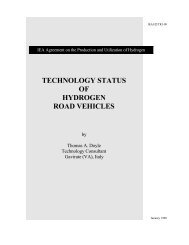Edited by Mary Rose de Valladares M.R.S. Enterprises, LLC ...
Edited by Mary Rose de Valladares M.R.S. Enterprises, LLC ...
Edited by Mary Rose de Valladares M.R.S. Enterprises, LLC ...
You also want an ePaper? Increase the reach of your titles
YUMPU automatically turns print PDFs into web optimized ePapers that Google loves.
ference of about 0.5V between the two<br />
cells (refer to Figure4). The H 2 produc<br />
tion rate varied with the choice of buffers<br />
and electrolytes. A feasible reaction<br />
mechanism has been <strong>de</strong>veloped.<br />
Figure4: Twochamber photo/bio<br />
catalytic hydrogen production system<br />
using a salt bridge (KIER).<br />
At Delft University of Technology<br />
(DUT), R&D on using Cdoped TiO 2 (an<br />
atase) as photoano<strong>de</strong> material contin<br />
ued. The Cdoped TiO 2 was produced<br />
<strong>by</strong> a post<strong>de</strong>position thermal treatment<br />
in an argon/hexane gas mixture. But<br />
as with similar efforts elsewhere, no<br />
enhanced photocatalytic activities have<br />
been found in the VIS part of the solar<br />
spectrum due to a too low concentra<br />
tion of carbon. Nevertheless, at low<br />
Cconcentrations the anatasetorutile<br />
phase transformation temperature was<br />
shifted beyond 800°C. This has the<br />
the temperature window for processing<br />
anatase TiO 2 based photocatalysts. Ad<br />
ditionally, investigations into using InVO 4<br />
as alternative photocatalyst material<br />
have started. Phasepure InVO 4 thin<br />
with a lowcost spray <strong>de</strong>position pro<br />
cess (refer to Figure5). Subbandgap<br />
optical absorption starts at ~1.9 eV,<br />
but is much less pronounced than the<br />
optical absorption of InVO4 in pow<strong>de</strong>r<br />
form that is observed <strong>by</strong> others. A small<br />
photocurrent was measured at energies<br />
above 2.75 eV. The true bandgap of<br />
the material is estimated to be 3.3 ± 0.3<br />
eV. The inci<strong>de</strong>nt photontocurrent ef<br />
wavelengths. This is attributed to a high<br />
donor <strong>de</strong>nsity in the material, which is<br />
estimated to be >2x10 20 cm 3 . Efforts to<br />
<strong>de</strong>crease the donor <strong>de</strong>nsity <strong>by</strong> counter<br />
doping with acceptortype dopants have<br />
not yet been successful, but studies<br />
continue.<br />
Figure5: Optical absorption spec<br />
(Delft).<br />
ence of doping / <strong>de</strong>fects sites on the<br />
local microscopic charge carrier mobili<br />
ties is being studied using a Terahertz<br />
(THz) Time Domain Spectrosopy setup.<br />
Small amounts of carbon dopant in ana<br />
tase TiO 2 enhance the recombination<br />
rate and <strong>de</strong>crease the number of free<br />
charge carriers <strong>by</strong> a factor of ~ 3. For<br />
Fedoped anatase, the recombination<br />
is even faster (~ 50 ps). Also at LU, the<br />
metal oxi<strong>de</strong> photoano<strong>de</strong> surface is being<br />
mo<strong>de</strong>lled with Quantum Transition State<br />
Theory (QTST). Density functional theo<br />
ry (DFT) is being employed to calculate<br />
the stability of the various dopants at the<br />
surface.<br />
At the University of Geneva (UG)<br />
as well as the Swiss Fe<strong>de</strong>ral Institute of<br />
Technology (EPFL), αFe 2 O 3 (hematite)<br />
photoano<strong>de</strong>s are being <strong>de</strong>veloped. At<br />
from spraypyrolysis of Fe(III)contain<br />
+ ing solutions and doped with Ti (5%)<br />
4<br />
+ and Al (1%) resulted in photocurrents<br />
3<br />
of 4.3 mA/cm 2 in 0.1 M NaOH (un<strong>de</strong>r<br />
aq<br />
4<br />
25<br />
“At low C<br />
concentrations the<br />
anatasetorutile<br />
phase transformation<br />
temperature was<br />
shifted beyond<br />
800°C. This has<br />
the advantage<br />
extending the<br />
temperature window<br />
for processing<br />
anatase TiO 2 based<br />
photocatalysts.”













